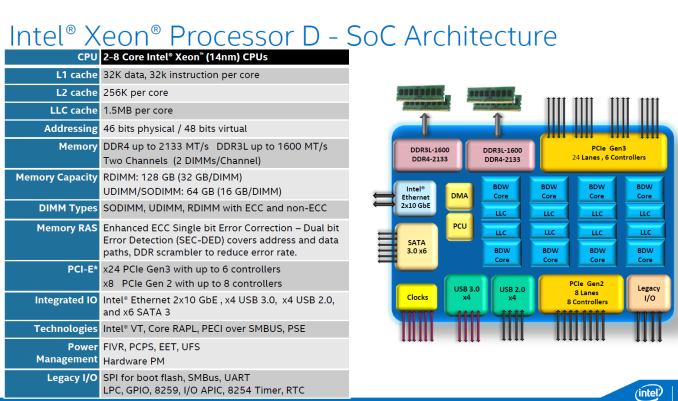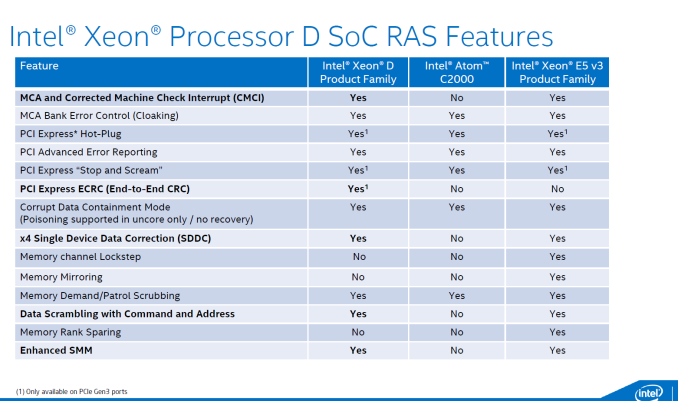The Intel Xeon D Review: Performance Per Watt Server SoC Champion?
by Johan De Gelas on June 23, 2015 8:35 AM EST- Posted in
- CPUs
- Intel
- Xeon-D
- Broadwell-DE
Broadwell in a Server SoC
In a nutshell, the Xeon D-1540 is two silicon dies in one highly integrated package. Eight 14 nm Broadwell cores, a shared L3-cache, a dual 10 gigabit MAC, a PCIe 3.0 root with 24 lanes find a home in the integrated SoC whereas in the same package we find four USB 3.0, four USB 2.0, six SATA3 controllers and a PCIe 2.0 root integrated in a PCH chip.
The Broadwell architecture brings small microarchitectural improvements - Intel currently claims about 5.5% higher IPC in integer processing. Other improvements include slightly lower VM exit/enter latencies, something that Intel has been improving with almost every recent generation (excluding Sandy Bridge).
Of course, if you are in the server business, you care little about all the small IPC improvements. Let us focus on the large relevant improvements. The big improvements over the Xeon E3-1200 v3 are:
- Twice as many cores and threads (8/16 vs 4/8)
- 32 GB instead of 8 GB per DIMM supported and support for DDR4-2133
- Maximum memory capacity has quadrupled (128 GB vs 32 GB)
- 24 PCIe 3.0 lanes instead of 16 PCIe 3.0 lanes
- 12 MB L3 rather than 8 MB L3
- No separate C22x chipset necessary for SATA / USB
- Dual 10 Gbit Ethernet integrated ...
And last but not least, RAS (Reliability, Availability and Servicability) features which are more similar to the Xeon E5:
The only RAS features missing in the Xeon D are the expensive ones like memory mirroring. Those RAS features a very rarely used, and The Xeon D can not offer them as it does not have a second memory controller.
Compared to the Atom C2000, the biggest improvement is the fact that the Broadwell core is vastly more advanced than the Silvermont core. That is not all:
- Atom C2000 had no L3-cache, and are thus a lot slower in situation where the cores have to sync a lot (databases)
- No support for USB 3 (Xeon D: four USB 3 controllers)
- As far as we know Atom C2000 server boards were limited to two 1 Gbit PHYs (unless you add a separate 10 GBe controller)
- No support for PCIe 3.0, "only" 16 PCIe Gen2 lanes.
There are more subtle differences of course such as using a crossbar rather than a ring, but those are beyond the scope of this review.













90 Comments
View All Comments
Flunk - Tuesday, June 23, 2015 - link
Yes, but it's still bad marketing. -D is associated with inferior, overly hot, bad performing Intel chips.IanHagen - Tuesday, June 23, 2015 - link
Certainly. From a marketing standpoint it's a pretty poor choice. I agree with wussupi, E4 would haven been a far better name.karpodiem - Tuesday, June 23, 2015 - link
does anyone know where to buy these online? I'm looking for just the board/processor, model # 'X10SDV-TLN4F'All these random/small Supermicro resellers are selling it now, based on some Google searches. They're marking it up in price by at least a hundred bucks, because availability is limited. Anyone know when Newegg might get it in stock?
Looking to do a FreeNAS build - this board + IBM M1015 card in an ATX motherboard (6x4TB drives in RAIDZ2).
ats - Tuesday, June 23, 2015 - link
The TLN4F is the one in most demand and almost no place is able to keep it in stock. There are multiple places that will order it for you for ~1K but wait times can be anywhere from 1 week to 1 month.Jon Tseng - Tuesday, June 23, 2015 - link
> And the reality is that the current SoCs with an ARM ISA do not deliver the necessary per core> performance: they are still micro server SoCs, at best competing with the Atom C2750. So
> currently, there is no ARM SoC competition in the scale out market until something better than
> the A57 hits the market for these big players.
Dude... You really want to have a look at the latest ThunderX parts or the X-Gene 16nm shrinks before you start making unwise statements like that. These aren't waiting around for A57 they are custom ARM architecture designs. Per core performance might not be as hot as Xeon but once you start to throw 48 cores on a die I wouldn't quite call that "at best competing with Avaton".
smoohta - Tuesday, June 23, 2015 - link
Link to reviews?ats - Tuesday, June 23, 2015 - link
X-Gene is in the article, any further shrinks are still entirely vapor. ThunderX isn't currently available is is likely to have significantly worse per core performance than Atom C2k series and worse than A57. All the cores in the world don't do jack if the ST isn't there. And ST performance IS a barrier even in scale out. For general scale out, C2750 was found fairly wanting because of the ST performance, and neither X-Gene nor ThunderX even compete with C2750 in ST performance... QED.mczak - Tuesday, June 23, 2015 - link
He said "currently". The X-Gene 16nm cores might offer some competition who knows - but those are X-Gene 3 whereas you can't even buy anything with X-Gene 2 28nm ones right now... Likewise, ThunderX servers have been announced, but I haven't seen any reviews yet.name99 - Tuesday, June 23, 2015 - link
Look at the ThunderX parts HOW? Cavium releases fsck-all information about them. No-one knows if they are even OoO, how wide they are, etc.Yes, there are 48 cores on a SoC; and presumably they will do well for tasks like memcached that like lots of low-performance parallelism. But right now, we have ZERO evidence that a ThunderX part is a better single-threaded core than A57, let alone that it's comparable to Broadwell.
der - Tuesday, June 23, 2015 - link
NOICE FAM!